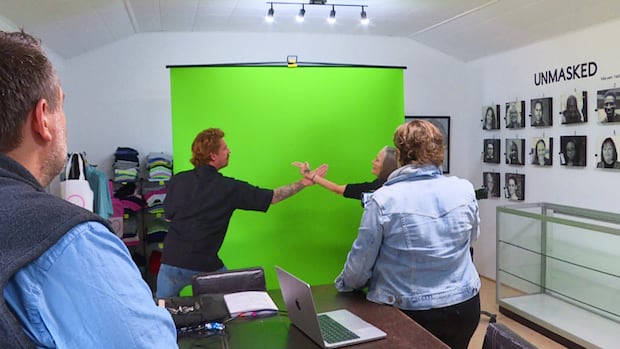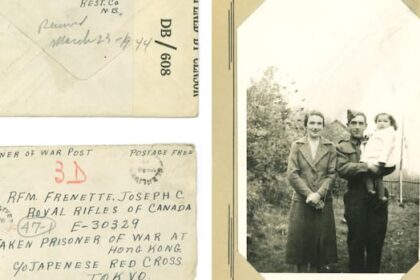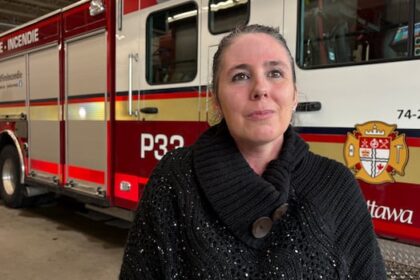When Betty Dare was growing up, she felt isolated, even from members of her own family. At the dinner table, they’d talk about their days. But Dare, who is the youngest of five, is Deaf and couldn’t understand their oral language.“All my family is hearing,” Dare said. “When I was using only oralism, a lot was missed in those interactions with hearing people.”Dare and others at the Deaf Arts Academy in the southeastern New Brunswick community of Grande-Digue spoke to CBC through certified American Sign Language interpreter Lauren Molloy for the interviews in this story.The Academy is a four-week retreat, fully organized by deaf artists. Here they’re able to collaborate and build their artistic practice in a fully Deaf environment, where ASL is the main language and everyone has deafness in common.When Dare, who is based in Montreal, began making art, she didn’t realize at first how deeply it connected to her Deaf experience.“For example, with my eye on my hand, that’s how I exist,” she said.De’VIA Artist Betty Dare says much of her art depicts the disconnect she feels with the hearing world as a deaf person. (Victoria Walton/CBC)It wasn’t until last year, when Dare heard about De’VIA — a type of Deaf art — that she realized she’d been doing it all along.De’VIA, or Deaf view image Art, is visual art. But De’VIA paintings, sculptures and drawings come from the Deaf perspective and often incorporate themes such as hands, lips, eyes and ears.“For example, with my eye on my hand, that’s how I exist,” Dare said. “So I want to showcase that. It’s my experience.“It’s boring to be around lips. I want to show that’s how I feel, so that’s really empowering.”The dream of Deaf artistsDe’VIA is just one type of art that students at the Deaf Arts Academy study.The Academy is a project of the Canadian Cultural Society of the Deaf, and students from all across Canada are invited to practice De’VIA, signed music, or signed theatre.“Something was missing across Canada,” said Leanne Gallant, executive director of the society. “We didn’t have anything run by Deaf people, any organizations that are Deaf-owned or run.“In Deaf culture, we have different metaphors compared to what hearing people would use. We need different opportunities for our expression, our stories.”The co-founders of the Deaf Arts Academy include, from left to right, Carlisle Robinson, Leanne Gallant, Joanne Cripps and Anita Small. (Victoria Walton/CBC)The Academy wrapped up its first four-week retreat in October at its new property in Grande-Digue.Previously owned by a group of nuns, the isolated, 1.6-hectare seaside property includes cabins, classrooms and a large communal kitchen where students and teachers share meals together.“This is a dream of so many Deaf artists to get together in a group, feel that connection, feel the inspiration,” said Gallant.The property in Grande-Digue was acquired in 2024, but it took until recently to get it up and running. The theatre course was held in Toronto for logistical reasons, but the first group to spend time in Grande-Digue realizes how important it is to have this space for the Deaf community.“This is our new era that we’re moving into,” Gallant said. “Our goal is to have more cabins added to the property, and we also want to set up a studio space.”Music without wordsThe idea of music for deaf people may seem counterintuitive at first. Even students like Kelowna, B.C’s Dellalee Piper didn’t fully understand when they started their first week at the Deaf Arts Academy.“I enjoyed signed music, but it was always from a translation. It wasn’t really something that matched Deaf culture,” said Piper.But Piper’s professors quickly explained that signed music isn’t the same as signing music, like you’d see an interpreter do on the side of the stage at a concert.WATCH | Creating music without sound, and art that speaks to the Deaf experience :Deaf artists now have a retreat to call their own in eastern N.B. communityFour-acre property in Grand-Digue doesn’t have the typical barriers that many Deaf people face in a largely hearing world.“There’s no auditory component included with it. You don’t use your ears at all for signed music,” said Piper. “There’s no auditory anything. It’s just the visuals.”Piper and her partner at the Academy stood in front of a green screen. He held the sign of a butterfly, and she held the sign of a dragonfly, and both danced together through the air, moving rhythmically.A the Deaf Arts Academy, on a seaside property in rural New Brunswick, is a place where artists can spend their days collaborating with each other both in and out of class. (Victoria Walton/CBC)Similar to the eyes, lips and hands of De’VIA, butterflies, dragonflies and fish are common symbols in Deaf arts, because these animals are also unable to hear.“It’s from my heart. It’s from who I am, my soul,” Piper said.Jody Cripps, a signed music professor at the Deaf Arts Academy, said it’s a new concept for many.“Deaf people for a long time are used to the assumption that music is for hearing people,” he said. “But hearing people don’t own music. It can be ours.”Opening new doorsThe academy is also a place for professional development. And more than that, it’s a space where Deaf artists can truly be themselves. They understand everything that is said, and can relate to each other’s experiences in a largely hearing world.“Coming together in the group really made me feel like I wasn’t alone,” said Piper. “It felt like a really family experience. So much love and so much togetherness.”Family is a word that many of the students and teachers used to describe the retreat.”This space here, it’s finally a Deaf community space that we’re welcome in,” said Maryam Hafizirad, a professor of De’VIA who’s based in Toronto.“It really feels like the Deaf community is like family here. Every morning we get up, we have breakfast, lunch, dinner, and it feels like a family interaction. It feels like that door is finally open.“Maryam Hazifirad, a De’VIA artist and teacher at the Deaf Arts Academy, says the Academy feels like home to her. (Victoria Walton/CBC)Pamela Witcher, another signed music professor at the Academy, says that having a space like the Deaf Arts Academy is crucial for the Deaf community to express themselves without fear.“We need to have the space, the time and really the permission to find our music,” she said. “We don’t have those opportunities out in the hearing world very often. There’s so many barriers.”For Betty Dare, her time in Grande-Digue has given her new insights on her own art, whether it’s about resisting the pressures of the hearing world, affirmation of her deaf experience, or liberation from the chains of auditory culture.“We want to emphasize that we have power,” she said. “It’s really emphasizing, and showing that Deaf people are just as equal to hearing people.”
It feels like family: Deaf artists collaborate and connect at New Brunswick retreat










